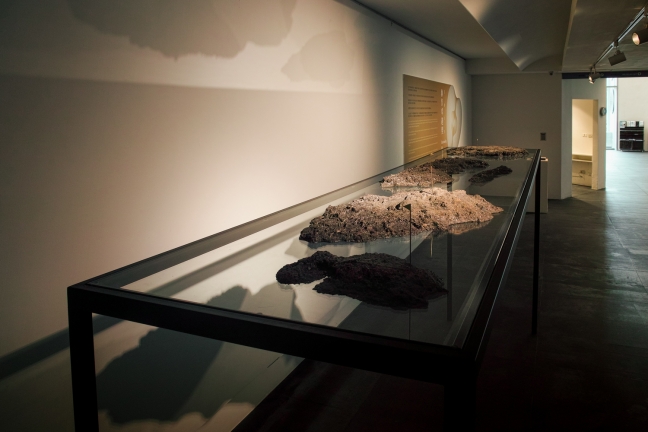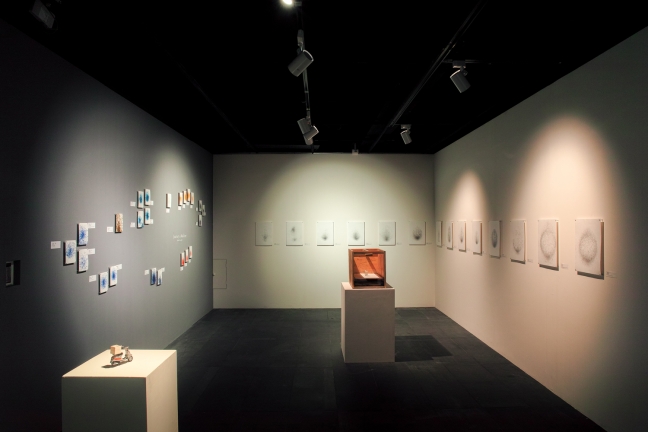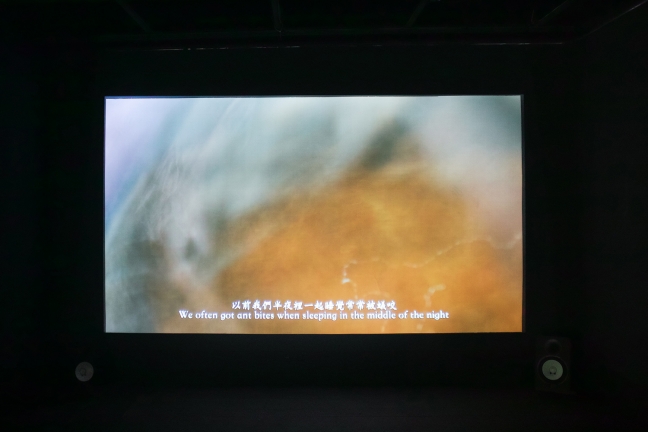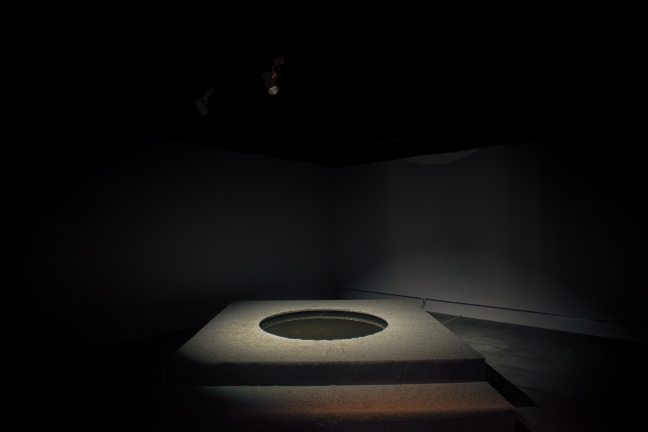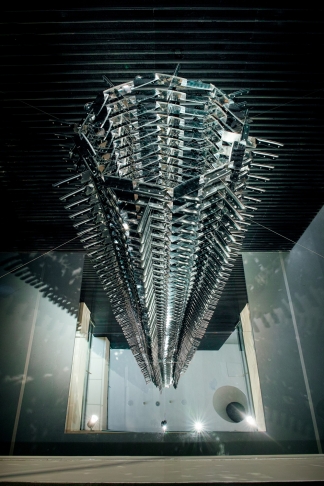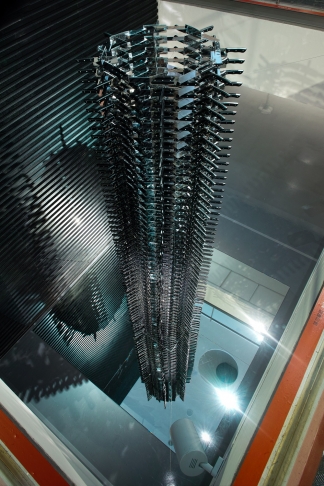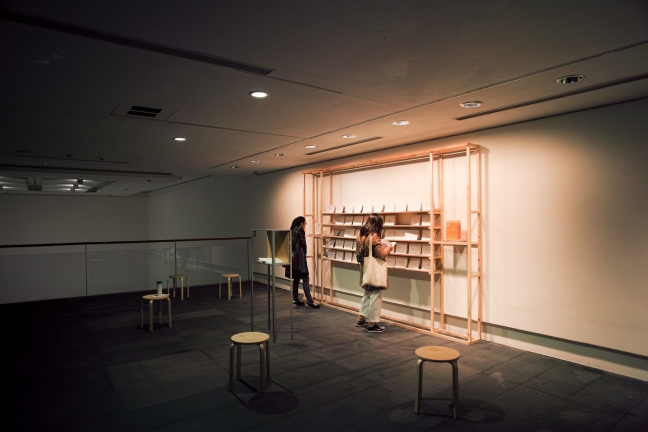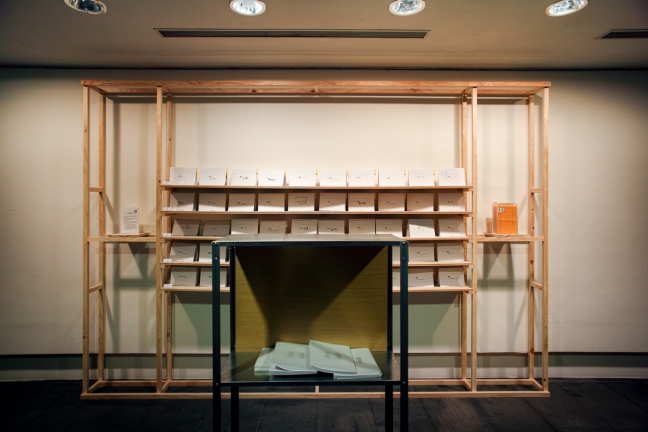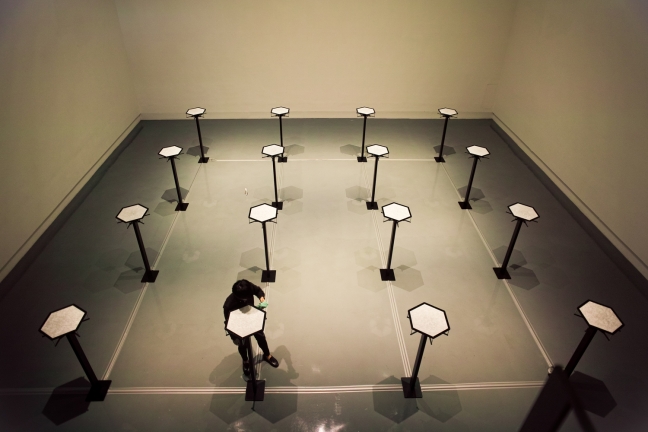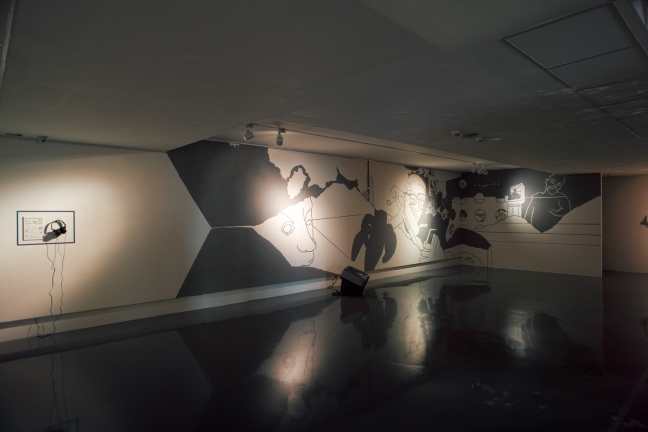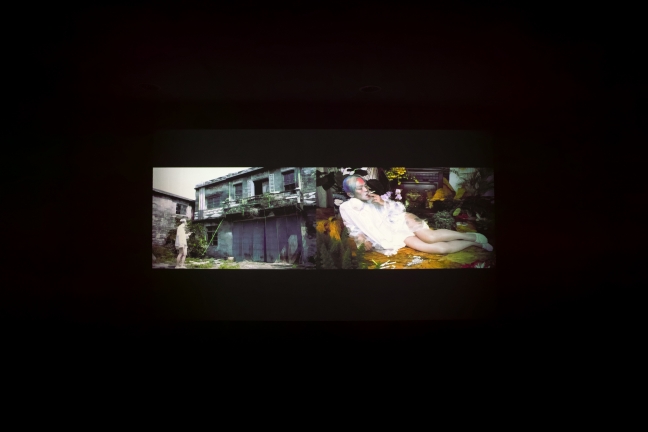2015 Outstanding Art Prize Exhibition: This is Not a Poisoned Apple
2015.03.06~2015.05.03
09:00 - 17:00
The winning entries of the 2015 Outstanding Art Prize are presented in the experimental exhibition, This is Not a Poisoned Apple, which features artists Wang Shao-Gang, Wu Ping Sheng, Chiu Yu-Chi, Wu Jian-Xing, Zhu Wen-Yi, Chen Yung-Zheng, Chen Guan-Hong, Sun Zhi-Xing, Chang Wen-Xuan, and Liu Xin-Ying, as well as the winner of the Curatorial Plan Category under the project titled Very Accident. This curatorial experiment asks the question of
Mirror, mirror on the wall, who's the fairest of them all?” from the story of Snow White. Corresponding to the artist’s creative process, baring your teeth and scowling at the mirror does not show who is
the fairest of them all”. Instead, it shows a reflection of the artist’s projected experiences. In the actual presentation of a work during art competitions, the artist’s personal notes on creative intent projects an imaginary self. With illumination shining from the other side, they conspire together to carefully
whitewash apples” for their work. In this apple, which is expected to be eaten by Snow White (the viewers), the blend of poison (the situation created by the work itself) infiltrates the current perception. The artist’s intent is submerged within the poison, leading the crowd that stands before the mirror, while projecting the summons reflected by the images of the mirror. In Haruki Murakami’s short novel, The Second Bakery Attack, because God, Marx, and John Lennon are all dead, the protagonist and his partner felt a strong sense of nothingness in addition to an empty stomach. Thus, they decided to rob a bakery. The threatened bakery owner proposed a deal using bread as a reward. The owner’s missionary-like commentary accompanied the robbers while they feasted on bread and listened closely to Wagner’s Tannhauser and The Flying Dutchman. This fulfilled the desires of both the owner and the robbers. The filling satisfaction eliminated the protagonist’s sense of emptiness that was originally caused by a lack of imagination. The bakery owner is actually like the incarnation of the artist. In the exchanged space and time, the author pulls in the viewer’s thoughts through the manipulation of intent, enabling the author’s own desire to be projected onto the recipients. After the incident, the impact on the protagonist and his partner became far greater than the specific issues that can be seen from the event. The vigorous ripples and vibrations also represent the variations of differences. In this experimental exhibition, the mirror = the circulation process of intent during the creative practice, while the apple = the presentation of the work. How can one effectively sugar-coat around the work, and re-open the touching emotion towards artworks and viewing experience?
Mirror, mirror on the wall, who's the fairest of them all?” from the story of Snow White. Corresponding to the artist’s creative process, baring your teeth and scowling at the mirror does not show who is
the fairest of them all”. Instead, it shows a reflection of the artist’s projected experiences. In the actual presentation of a work during art competitions, the artist’s personal notes on creative intent projects an imaginary self. With illumination shining from the other side, they conspire together to carefully
whitewash apples” for their work. In this apple, which is expected to be eaten by Snow White (the viewers), the blend of poison (the situation created by the work itself) infiltrates the current perception. The artist’s intent is submerged within the poison, leading the crowd that stands before the mirror, while projecting the summons reflected by the images of the mirror. In Haruki Murakami’s short novel, The Second Bakery Attack, because God, Marx, and John Lennon are all dead, the protagonist and his partner felt a strong sense of nothingness in addition to an empty stomach. Thus, they decided to rob a bakery. The threatened bakery owner proposed a deal using bread as a reward. The owner’s missionary-like commentary accompanied the robbers while they feasted on bread and listened closely to Wagner’s Tannhauser and The Flying Dutchman. This fulfilled the desires of both the owner and the robbers. The filling satisfaction eliminated the protagonist’s sense of emptiness that was originally caused by a lack of imagination. The bakery owner is actually like the incarnation of the artist. In the exchanged space and time, the author pulls in the viewer’s thoughts through the manipulation of intent, enabling the author’s own desire to be projected onto the recipients. After the incident, the impact on the protagonist and his partner became far greater than the specific issues that can be seen from the event. The vigorous ripples and vibrations also represent the variations of differences. In this experimental exhibition, the mirror = the circulation process of intent during the creative practice, while the apple = the presentation of the work. How can one effectively sugar-coat around the work, and re-open the touching emotion towards artworks and viewing experience?
The winning entries of the 2015 Outstanding Art Prize are presented in the experimental exhibition, This is Not a Poisoned Apple, which features artists Wang Shao-Gang, Wu Ping Sheng, Chiu Yu-Chi, Wu Jian-Xing, Zhu Wen-Yi, Chen Yung-Zheng, Chen Guan-Hong, Sun Zhi-Xing, Chang Wen-Xuan, and Liu Xin-Ying, as well as the winner of the Curatorial Plan Category under the project titled Very Accident. This curatorial experiment asks the question of
Mirror, mirror on the wall, who's the fairest of them all?” from the story of Snow White. Corresponding to the artist’s creative process, baring your teeth and scowling at the mirror does not show who is
the fairest of them all”. Instead, it shows a reflection of the artist’s projected experiences. In the actual presentation of a work during art competitions, the artist’s personal notes on creative intent projects an imaginary self. With illumination shining from the other side, they conspire together to carefully
whitewash apples” for their work. In this apple, which is expected to be eaten by Snow White (the viewers), the blend of poison (the situation created by the work itself) infiltrates the current perception. The artist’s intent is submerged within the poison, leading the crowd that stands before the mirror, while projecting the summons reflected by the images of the mirror. In Haruki Murakami’s short novel, The Second Bakery Attack, because God, Marx, and John Lennon are all dead, the protagonist and his partner felt a strong sense of nothingness in addition to an empty stomach. Thus, they decided to rob a bakery. The threatened bakery owner proposed a deal using bread as a reward. The owner’s missionary-like commentary accompanied the robbers while they feasted on bread and listened closely to Wagner’s Tannhauser and The Flying Dutchman. This fulfilled the desires of both the owner and the robbers. The filling satisfaction eliminated the protagonist’s sense of emptiness that was originally caused by a lack of imagination. The bakery owner is actually like the incarnation of the artist. In the exchanged space and time, the author pulls in the viewer’s thoughts through the manipulation of intent, enabling the author’s own desire to be projected onto the recipients. After the incident, the impact on the protagonist and his partner became far greater than the specific issues that can be seen from the event. The vigorous ripples and vibrations also represent the variations of differences. In this experimental exhibition, the mirror = the circulation process of intent during the creative practice, while the apple = the presentation of the work. How can one effectively sugar-coat around the work, and re-open the touching emotion towards artworks and viewing experience?
Mirror, mirror on the wall, who's the fairest of them all?” from the story of Snow White. Corresponding to the artist’s creative process, baring your teeth and scowling at the mirror does not show who is
the fairest of them all”. Instead, it shows a reflection of the artist’s projected experiences. In the actual presentation of a work during art competitions, the artist’s personal notes on creative intent projects an imaginary self. With illumination shining from the other side, they conspire together to carefully
whitewash apples” for their work. In this apple, which is expected to be eaten by Snow White (the viewers), the blend of poison (the situation created by the work itself) infiltrates the current perception. The artist’s intent is submerged within the poison, leading the crowd that stands before the mirror, while projecting the summons reflected by the images of the mirror. In Haruki Murakami’s short novel, The Second Bakery Attack, because God, Marx, and John Lennon are all dead, the protagonist and his partner felt a strong sense of nothingness in addition to an empty stomach. Thus, they decided to rob a bakery. The threatened bakery owner proposed a deal using bread as a reward. The owner’s missionary-like commentary accompanied the robbers while they feasted on bread and listened closely to Wagner’s Tannhauser and The Flying Dutchman. This fulfilled the desires of both the owner and the robbers. The filling satisfaction eliminated the protagonist’s sense of emptiness that was originally caused by a lack of imagination. The bakery owner is actually like the incarnation of the artist. In the exchanged space and time, the author pulls in the viewer’s thoughts through the manipulation of intent, enabling the author’s own desire to be projected onto the recipients. After the incident, the impact on the protagonist and his partner became far greater than the specific issues that can be seen from the event. The vigorous ripples and vibrations also represent the variations of differences. In this experimental exhibition, the mirror = the circulation process of intent during the creative practice, while the apple = the presentation of the work. How can one effectively sugar-coat around the work, and re-open the touching emotion towards artworks and viewing experience?

